The Cambridge History of Japan, Vol. 3: Medieval Japan
Подождите немного. Документ загружается.

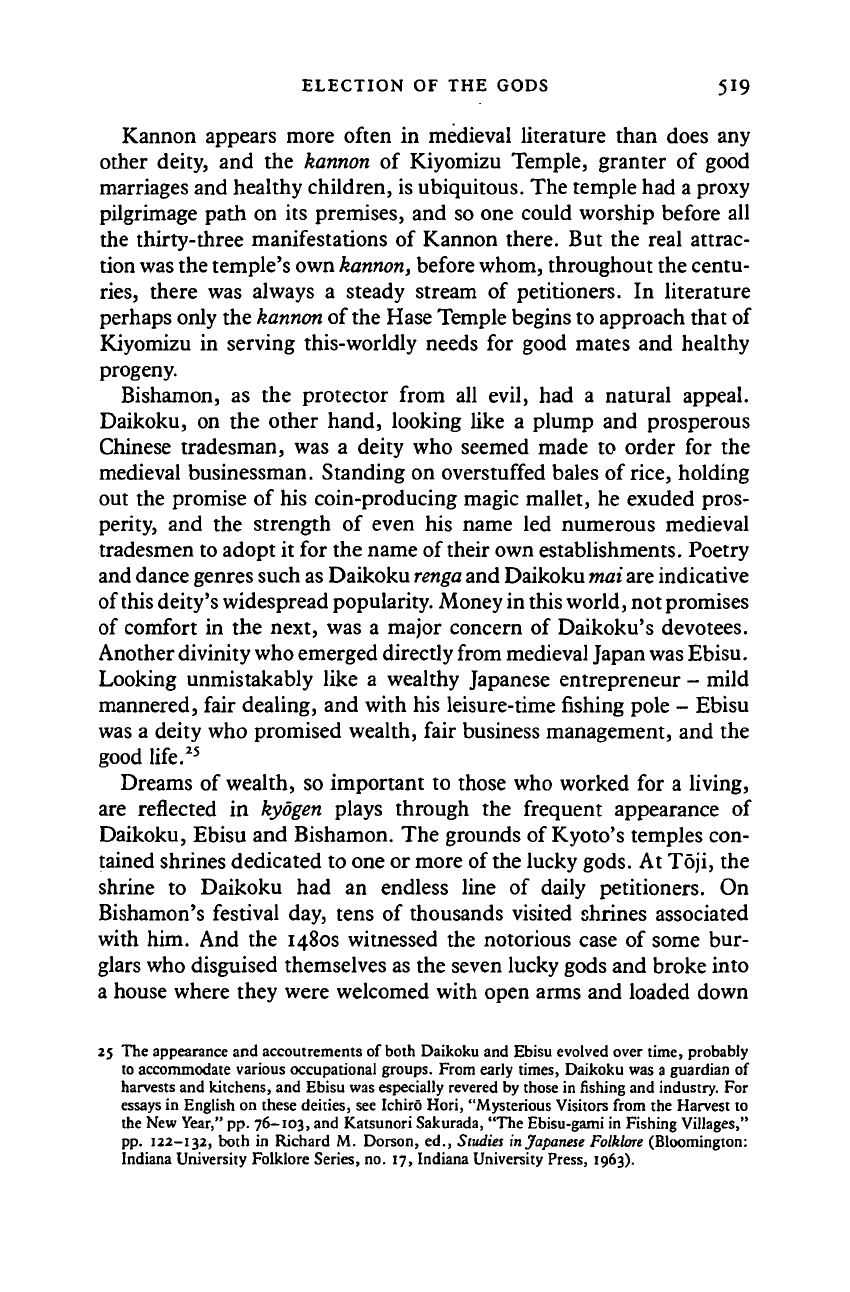
ELECTION OF THE GODS 519
Kannon appears more often in medieval literature than does any
other deity, and the kannon of Kiyomizu Temple, granter of good
marriages and healthy children, is ubiquitous. The temple had a proxy
pilgrimage path on its premises, and so one could worship before all
the thirty-three manifestations of Kannon there. But the real attrac-
tion
was
the temple's own
kannon,
before whom, throughout the centu-
ries,
there was always a steady stream of petitioners. In literature
perhaps only the
kannon
of
the
Hase Temple begins to approach that of
Kiyomizu in serving this-worldly needs for good mates and healthy
progeny.
Bishamon, as the protector from all evil, had a natural appeal.
Daikoku, on the other hand, looking like a plump and prosperous
Chinese tradesman, was a deity who seemed made to order for the
medieval businessman. Standing on overstuffed bales of
rice,
holding
out the promise of his coin-producing magic mallet, he exuded pros-
perity, and the strength of even his name led numerous medieval
tradesmen to adopt it for the name of their own establishments. Poetry
and dance genres such
as
Daikoku
renga
and Daikoku
mai are
indicative
of this deity's widespread popularity. Money
in this
world,
not promises
of comfort in the next, was a major concern of Daikoku's devotees.
Another divinity
who
emerged directly from medieval Japan
was
Ebisu.
Looking unmistakably like a wealthy Japanese entrepreneur - mild
mannered, fair dealing, and with his leisure-time fishing pole - Ebisu
was a deity who promised wealth, fair business management, and the
good life.
25
Dreams of wealth, so important to those who worked for a living,
are reflected in kyogen plays through the frequent appearance of
Daikoku, Ebisu and Bishamon. The grounds of Kyoto's temples con-
tained shrines dedicated to one or more of
the
lucky gods. At Toji, the
shrine to Daikoku had an endless line of daily petitioners. On
Bishamon's festival day, tens of thousands visited shrines associated
with him. And the 1480s witnessed the notorious case of some bur-
glars who disguised themselves as the seven lucky gods and broke into
a house where they were welcomed with open arms and loaded down
25 The appearance and accoutrements of both Daikoku and Ebisu evolved over time, probably
to accommodate various occupational groups. From early times, Daikoku was a guardian of
harvests and kitchens, and Ebisu was especially revered by those in fishing and industry. For
essays in English on these deities, see Ichiro Hori, "Mysterious Visitors from the Harvest to
the New Year," pp. 76-103, and Katsunori Sakurada, "The Ebisu-gami in Fishing Villages,"
pp.
122-132, both in Richard M. Dorson, ed., Studies in Japanese Folklore (Bloomington:
Indiana University Folklore Series, no. 17, Indiana University Press, 1963).
Cambridge Histories Online © Cambridge University Press, 2008
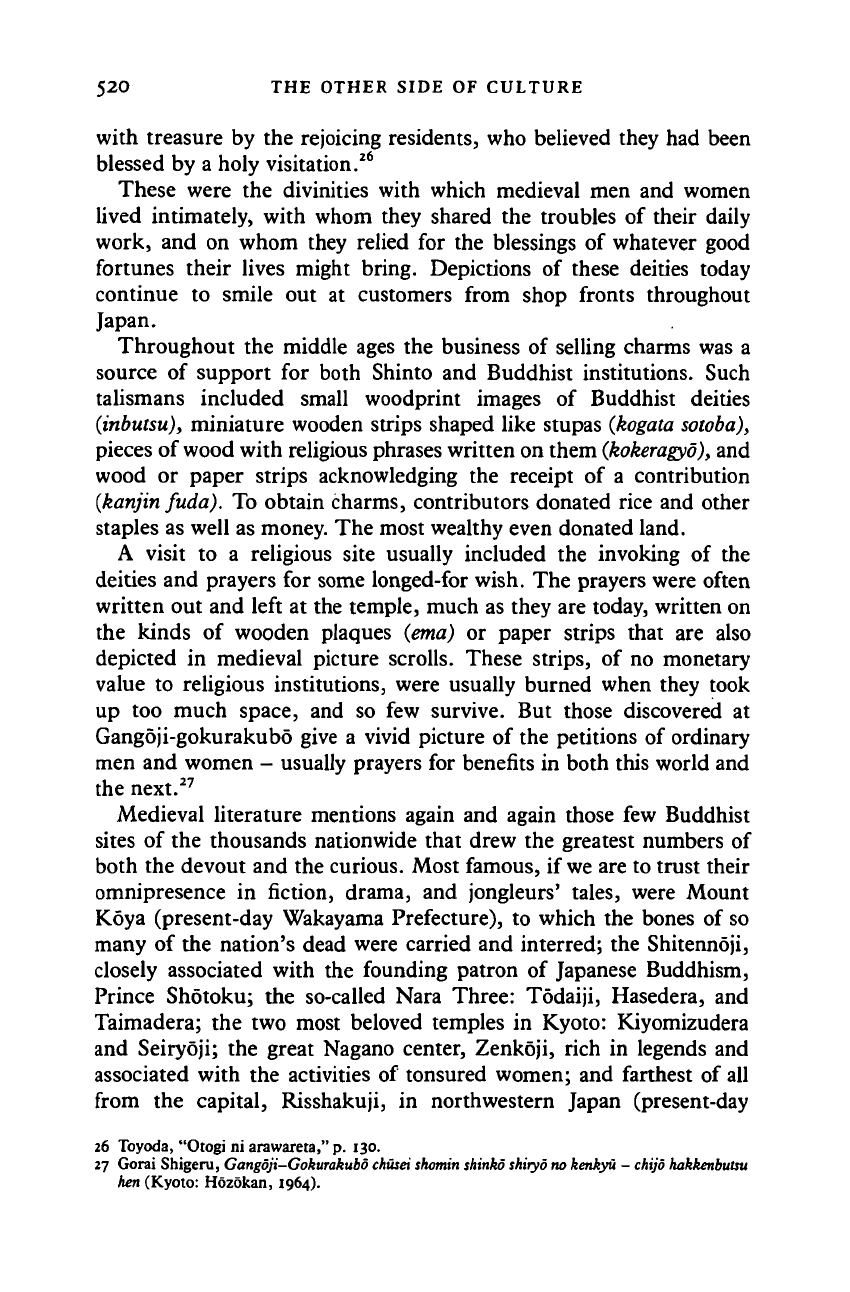
520 THE OTHER SIDE OF CULTURE
with treasure by the rejoicing residents, who believed they had been
blessed by a holy visitation.
26
These were the divinities with which medieval men and women
lived intimately, with whom they shared the troubles of their daily
work, and on whom they relied for the blessings of whatever good
fortunes their lives might bring. Depictions of these deities today
continue to smile out at customers from shop fronts throughout
Japan.
Throughout the middle ages the business of selling charms was a
source of support for both Shinto and Buddhist institutions. Such
talismans included small woodprint images of Buddhist deities
(inbutsu),
miniature wooden strips shaped like stupas
(kogata
sotoba),
pieces of wood with religious phrases written on them
(kokeragyo),
and
wood or paper strips acknowledging the receipt of a contribution
(kanjin
fuda). To obtain charms, contributors donated rice and other
staples as well as money. The most wealthy even donated land.
A visit to a religious site usually included the invoking of the
deities and prayers for some longed-for wish. The prayers were often
written out and left at the temple, much as they are today, written on
the kinds of wooden plaques (etna) or paper strips that are also
depicted in medieval picture scrolls. These strips, of no monetary
value to religious institutions, were usually burned when they took
up too much space, and so few survive. But those discovered at
Gangoji-gokurakubo give a vivid picture of the petitions of ordinary
men and women - usually prayers for benefits in both this world and
the next.
27
Medieval literature mentions again and again those few Buddhist
sites of the thousands nationwide that drew the greatest numbers of
both the devout and the curious. Most famous, if
we
are to trust their
omnipresence in fiction, drama, and jongleurs' tales, were Mount
Koya (present-day Wakayama Prefecture), to which the bones of so
many of the nation's dead were carried and interred; the Shitennoji,
closely associated with the founding patron of Japanese Buddhism,
Prince Shotoku; the so-called Nara Three: Todaiji, Hasedera, and
Taimadera; the two most beloved temples in Kyoto: Kiyomizudera
and Seiryoji; the great Nagano center, Zenkoji, rich in legends and
associated with the activities of tonsured women; and farthest of all
from the capital, Risshakuji, in northwestern Japan (present-day
26
Toyoda,
"Otogi
ni
arawareta,"
p.
130.
27 Gorai
Shigeru, Gangoji-Gokurakubo
chusei shomin shinko shiryo
no
kenkyu
-
chijo hakkenbutsu
hen (Kyoto:
Hozokan,
1964).
Cambridge Histories Online © Cambridge University Press, 2008
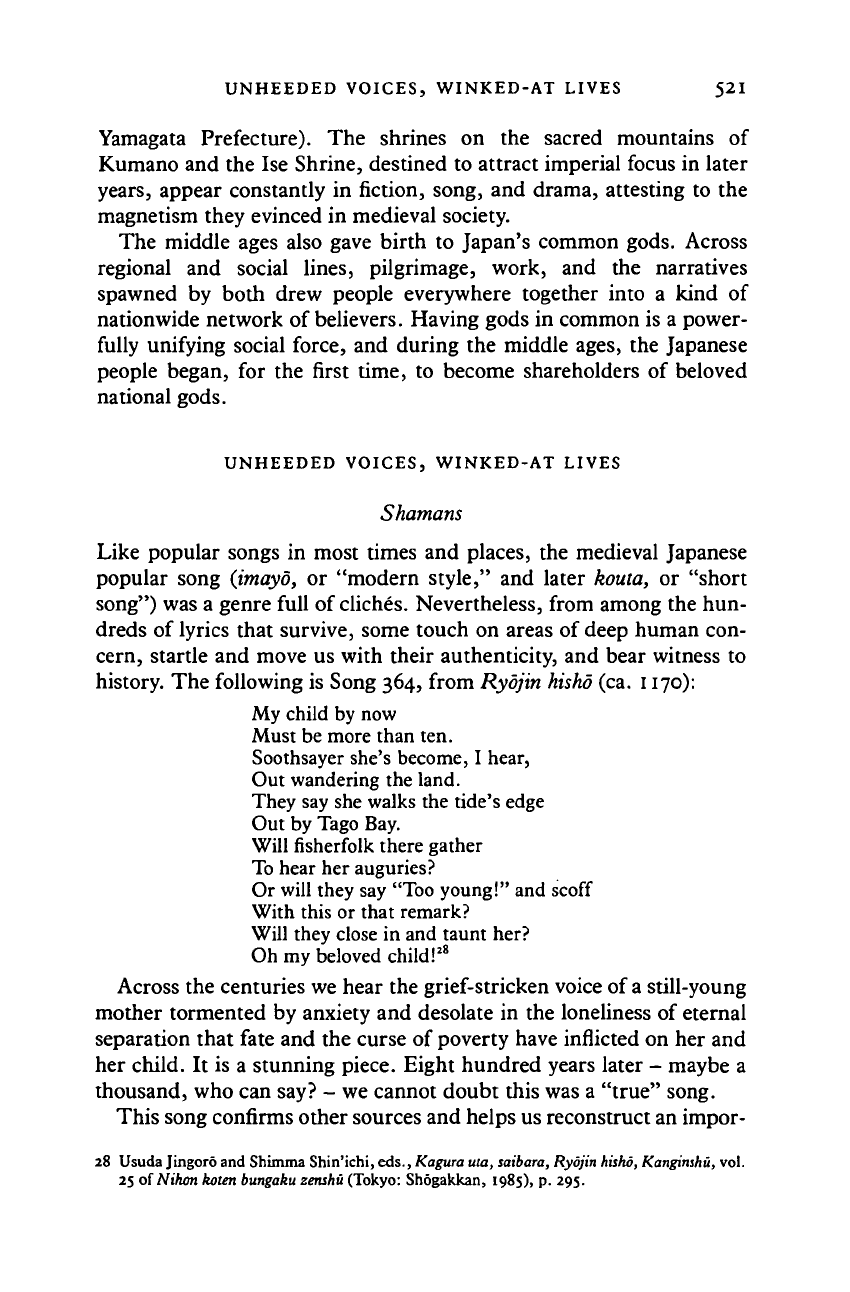
UNHEEDED VOICES, WINKED-AT LIVES 521
Yamagata Prefecture). The shrines on the sacred mountains of
Kumano and the Ise Shrine, destined to attract imperial focus in later
years,
appear constantly in fiction, song, and drama, attesting to the
magnetism they evinced in medieval society.
The middle ages also gave birth to Japan's common gods. Across
regional and social lines, pilgrimage, work, and the narratives
spawned by both drew people everywhere together into a kind of
nationwide network of believers. Having gods in common is a power-
fully unifying social force, and during the middle ages, the Japanese
people began, for the first time, to become shareholders of beloved
national gods.
UNHEEDED VOICES, WINKED-AT LIVES
Shamans
Like popular songs in most times and places, the medieval Japanese
popular song {imayo, or "modern style," and later kouta, or "short
song") was a genre full of cliches. Nevertheless, from among the hun-
dreds of lyrics that survive, some touch on areas of deep human con-
cern, startle and move us with their authenticity, and bear witness to
history. The following is Song 364, from Ryojin hisho (ca. 1170):
My child by now
Must be more than ten.
Soothsayer she's become, I hear,
Out wandering the land.
They say she walks the tide's edge
Out by Tago Bay.
Will fisherfolk there gather
To hear her auguries?
Or will they say "Too young!" and scoff
With this or that remark?
Will they close in and taunt her?
Oh my beloved child!
28
Across the centuries we hear the grief-stricken voice of
a
still-young
mother tormented by anxiety and desolate in the loneliness of eternal
separation that fate and the curse of poverty have inflicted on her and
her child. It is a stunning piece. Eight hundred years later - maybe a
thousand, who can say? - we cannot doubt this was a "true" song.
This song confirms other sources and helps us reconstruct an impor-
28 Usuda Jingoro and Shimma Shin'ichi, eds., Kagura ma, saibara, Ryojin
hisho,
Kangituhu, vol.
25 oiNihon koten bungaku zenshu (Tokyo: Shogakkan, 1985), p. 295.
Cambridge Histories Online © Cambridge University Press, 2008
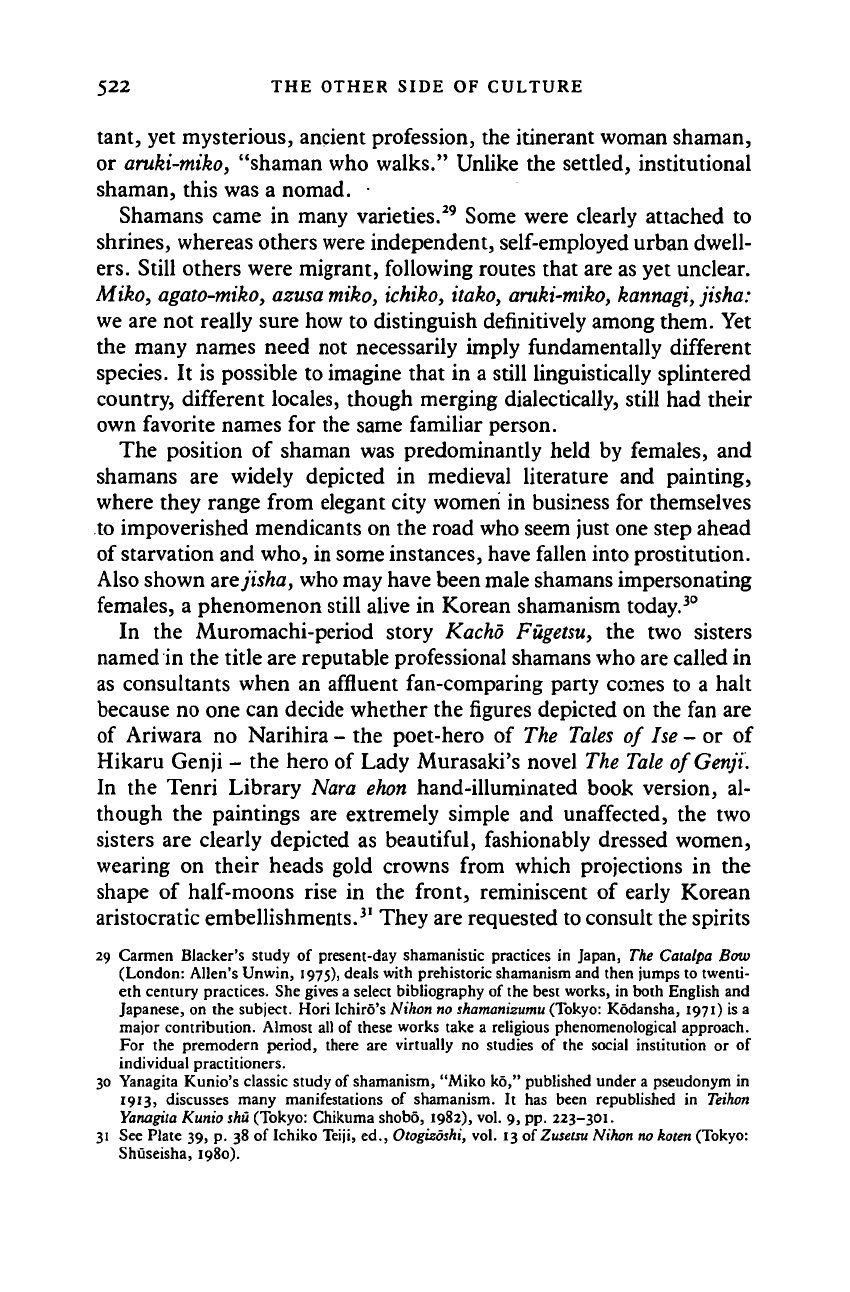
522 THE OTHER SIDE OF CULTURE
tant, yet mysterious, ancient profession, the itinerant woman shaman,
or
aruki-miko,
"shaman who walks." Unlike the settled, institutional
shaman, this was a nomad. •
Shamans came in many varieties.
29
Some were clearly attached to
shrines, whereas others were independent, self-employed urban dwell-
ers.
Still others were migrant, following routes that are as yet unclear.
Miko,
agato-miko,
azusa
miko,
ichiko,
itako,
aruki-miko,
kannagi,
jisha:
we are not really sure how to distinguish definitively among them. Yet
the many names need not necessarily imply fundamentally different
species. It is possible to imagine that in a still linguistically splintered
country, different locales, though merging dialectically, still had their
own favorite names for the same familiar person.
The position of shaman was predominantly held by females, and
shamans are widely depicted in medieval literature and painting,
where they range from elegant city women in business for themselves
to impoverished mendicants on the road who seem just one step ahead
of starvation and who, in some instances, have fallen into prostitution.
Also shown are jisha, who may have been male shamans impersonating
females, a phenomenon still alive in Korean shamanism today.
30
In the Muromachi-period story Kacho Fugetsu, the two sisters
named in the title are reputable professional shamans who are called in
as consultants when an affluent fan-comparing party conies to a halt
because no one can decide whether the figures depicted on the fan are
of Ariwara no Narihira - the poet-hero of The
Tales
of Ise - or of
Hikaru Genji - the hero of Lady Murasaki's novel The
Tale
ofGenji.
In the Tenri Library Nara
ehon
hand-illuminated book version, al-
though the paintings are extremely simple and unaffected, the two
sisters are clearly depicted as beautiful, fashionably dressed women,
wearing on their heads gold crowns from which projections in the
shape of half-moons rise in the front, reminiscent of early Korean
aristocratic embellishments.
31
They are requested to consult the spirits
29 Carmen Blacker's study of present-day shamanistic practices in Japan, The Catalpa Bow
(London: Allen's Unwin, 1975), deals with prehistoric shamanism and then jumps to twenti-
eth century practices. She gives a select bibliography of the best works, in both English and
Japanese, on the subject. Hori Ichiro's Nihon no
shamanizumu
(Tokyo: Kodansha, 1971) is a
major contribution. Almost all of these works take a religious phenomenological approach.
For the premodern period, there are virtually no studies of the social institution or of
individual practitioners.
30 Yanagita Kunio's classic study of shamanism, "Miko ko," published under a pseudonym in
1913,
discusses many manifestations of shamanism. It has been republished in Teihon
Yanagita
Kunio
shu
(Tokyo: Chikuma shobo, 1982), vol. 9, pp. 223-301.
31 See Plate 39, p. 38 of Ichiko Teiji, ed., Otogizoshi, vol. 13 of
Zusetsu
Nihon
no koien
(Tokyo:
Shuseisha, 1980).
Cambridge Histories Online © Cambridge University Press, 2008
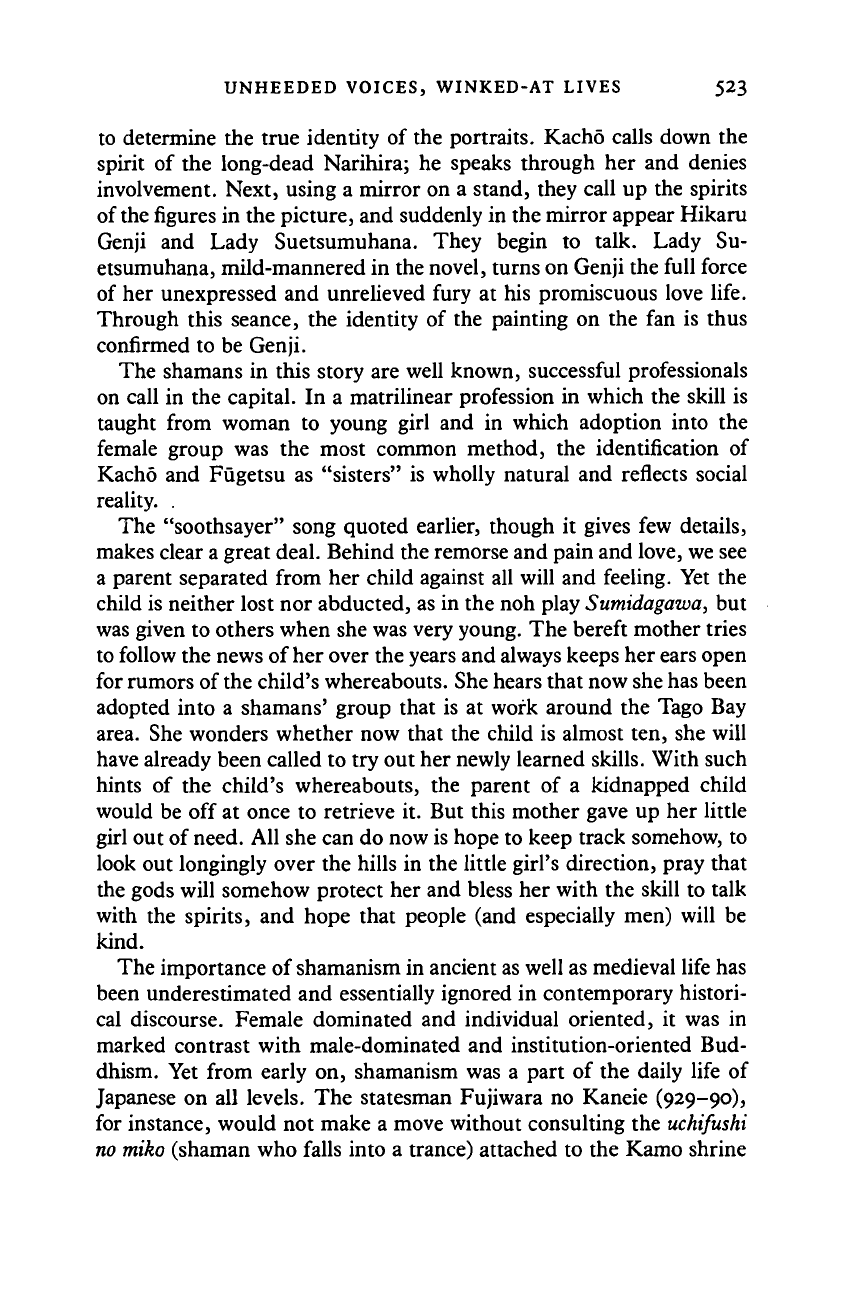
UNHEEDED VOICES, WINKED-AT LIVES 523
to determine the true identity of the portraits. Kacho calls down the
spirit of the long-dead Narihira; he speaks through her and denies
involvement. Next, using a mirror on a stand, they call up the spirits
of the
figures
in the picture, and suddenly in the mirror appear Hikaru
Genji and Lady Suetsumuhana. They begin to talk. Lady Su-
etsumuhana, mild-mannered in the novel, turns on Genji the full force
of her unexpressed and unrelieved fury at his promiscuous love life.
Through this seance, the identity of the painting on the fan is thus
confirmed to be Genji.
The shamans in this story are well known, successful professionals
on call in the capital. In a matrilinear profession in which the skill is
taught from woman to young girl and in which adoption into the
female group was the most common method, the identification of
Kacho and Fugetsu as "sisters" is wholly natural and reflects social
reality. .
The "soothsayer" song quoted earlier, though it gives few details,
makes clear a great deal. Behind the remorse and pain and love, we see
a parent separated from her child against all will and feeling. Yet the
child is neither lost nor abducted, as in the noh play
Sumidagawa,
but
was given to others when she was very young. The bereft mother tries
to follow the news of her over the years and always keeps her ears open
for rumors of the child's whereabouts. She hears that now she has been
adopted into a shamans' group that is at work around the Tago Bay
area. She wonders whether now that the child is almost ten, she will
have already been called to try out her newly learned skills. With such
hints of the child's whereabouts, the parent of a kidnapped child
would be off at once to retrieve it. But this mother gave up her little
girl out of
need.
All she can do now is hope to keep track somehow, to
look out longingly over the hills in the little girl's direction, pray that
the gods will somehow protect her and bless her with the skill to talk
with the spirits, and hope that people (and especially men) will be
kind.
The importance of shamanism in ancient as well as medieval life has
been underestimated and essentially ignored in contemporary histori-
cal discourse. Female dominated and individual oriented, it was in
marked contrast with male-dominated and institution-oriented Bud-
dhism. Yet from early on, shamanism was a part of the daily life of
Japanese on all levels. The statesman Fujiwara no Kaneie (929-90),
for instance, would not make a move without consulting the
uchifushi
no miko
(shaman who falls into a trance) attached to the Kamo shrine
Cambridge Histories Online © Cambridge University Press, 2008
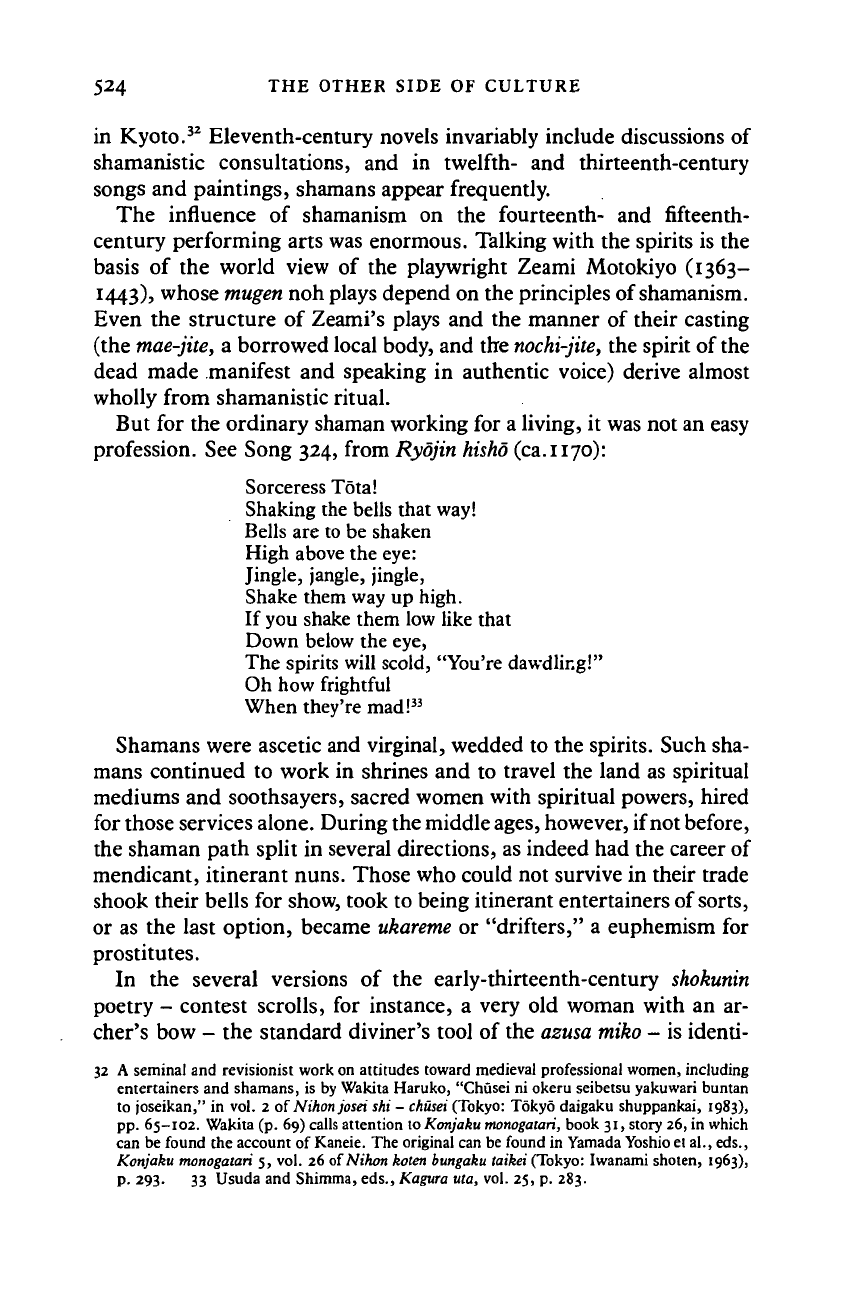
524 THE OTHER SIDE OF CULTURE
in Kyoto.
32
Eleventh-century novels invariably include discussions of
shamanistic consultations, and in twelfth- and thirteenth-century
songs and paintings, shamans appear frequently.
The influence of shamanism on the fourteenth- and fifteenth-
century performing arts was enormous. Talking with the spirits is the
basis of the world view of the playwright Zeami Motokiyo
(1363-
1443),
whose mugen noh plays depend on the principles of shamanism.
Even the structure of Zeami's plays and the manner of their casting
(the mae-jite, a borrowed local body, and the nochi-jite, the spirit of the
dead made manifest and speaking in authentic voice) derive almost
wholly from shamanistic ritual.
But for the ordinary shaman working for a living, it was not an easy
profession. See Song 324, from Ryojin hisho (ca.1170):
Sorceress Total
Shaking the bells that way!
Bells are to be shaken
High above the eye:
Jingle, jangle, jingle,
Shake them way up high.
If you shake them low like that
Down below the eye,
The spirits will scold, "You're dawdling!"
Oh how frightful
When they're mad!
33
Shamans were ascetic and virginal, wedded to the spirits. Such sha-
mans continued to work in shrines and to travel the land as spiritual
mediums and soothsayers, sacred women with spiritual powers, hired
for those services alone. During the middle
ages,
however, if not before,
the shaman path split in several directions, as indeed had the career of
mendicant, itinerant nuns. Those who could not survive in their trade
shook their bells for show, took to being itinerant entertainers of sorts,
or as the last option, became ukareme or "drifters," a euphemism for
prostitutes.
In the several versions of the early-thirteenth-century shokunin
poetry - contest scrolls, for instance, a very old woman with an ar-
cher's bow - the standard diviner's tool of the azusa miko - is identi-
32 A seminal and revisionist work on attitudes toward medieval professional women, including
entertainers and shamans, is by Wakita Haruko, "Chusei ni okeru seibetsu yakuwari buntan
to joseikan," in vol. 2 of Nihonjosei shi - chusei (Tokyo: Tokyo daigaku shuppankai, 1983),
pp.
65-102. Wakita (p. 69) calls attention to Konjaku
monogatari,
book 31, story 26, in which
can be found the account of Kaneie. The original can be found in Yamada Yoshio et al., eds.,
Konjaku monogatari 5, vol. 26 of Nikon koten bungaku taikei (Tokyo: Iwanami shoten, 1963),
P-
293. 33 Usuda and Shimma, eds., Kagura uta, vol. 25, p. 283.
Cambridge Histories Online © Cambridge University Press, 2008
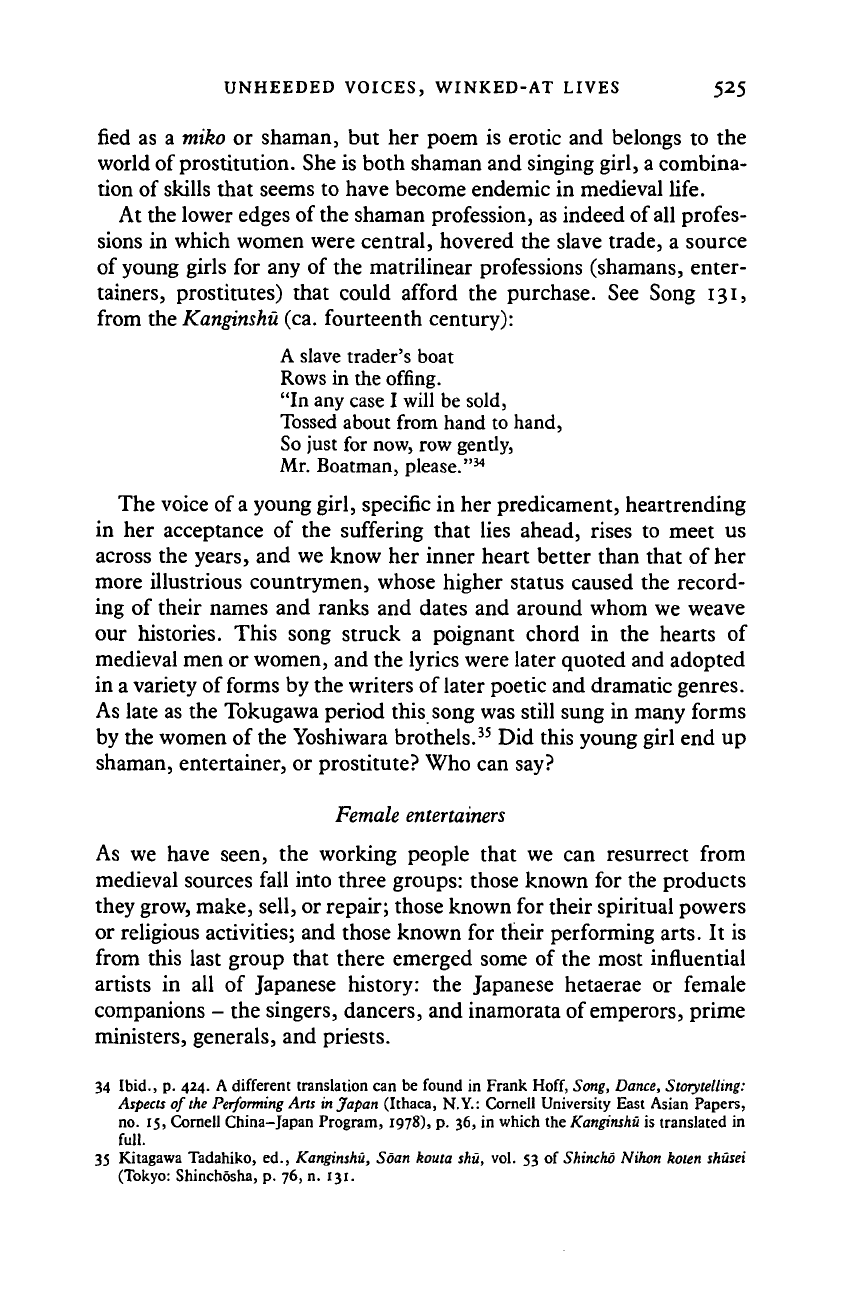
UNHEEDED VOICES, WINKED-AT LIVES 525
fied as a miko or shaman, but her poem is erotic and belongs to the
world of prostitution. She is both shaman and singing girl, a combina-
tion of skills that seems to have become endemic in medieval life.
At the lower edges of the shaman profession, as indeed of all profes-
sions in which women were central, hovered the slave trade, a source
of young girls for any of the matrilinear professions (shamans, enter-
tainers, prostitutes) that could afford the purchase. See Song 131,
from the Kanginshu (ca. fourteenth century):
A slave trader's boat
Rows in the offing.
"In any case I will be sold,
Tossed about from hand to hand,
So just for now, row gently,
Mr. Boatman, please."
34
The voice of a young girl, specific in her predicament, heartrending
in her acceptance of the suffering that lies ahead, rises to meet us
across the years, and we know her inner heart better than that of her
more illustrious countrymen, whose higher status caused the record-
ing of their names and ranks and dates and around whom we weave
our histories. This song struck a poignant chord in the hearts of
medieval men or women, and the lyrics were later quoted and adopted
in a variety of forms by the writers of later poetic and dramatic genres.
As late as the Tokugawa period this song was still sung in many forms
by the women of the Yoshiwara brothels.
35
Did this young girl end up
shaman, entertainer, or prostitute? Who can say?
Female entertainers
As we have seen, the working people that we can resurrect from
medieval sources fall into three groups: those known for the products
they grow, make, sell, or repair; those known for their spiritual powers
or religious activities; and those known for their performing arts. It is
from this last group that there emerged some of the most influential
artists in all of Japanese history: the Japanese hetaerae or female
companions - the singers, dancers, and inamorata of emperors, prime
ministers, generals, and priests.
34 Ibid., p. 424. A different translation can be found in Frank
Hoff,
Song, Dance, Storytelling:
Aspects of
the
Performing Arts
in
Japan (Ithaca, N.Y.: Cornell University East Asian Papers,
no.
15, Cornell China-Japan Program, 1978), p. 36, in which the Kanginshu is translated in
full.
35 Kitagawa Tadahiko, ed., Kanginshu, Soan kouta shu, vol. 53 of Shincho Nihon koten shusei
(Tokyo: Shinchosha, p. 76, n. 131.
Cambridge Histories Online © Cambridge University Press, 2008
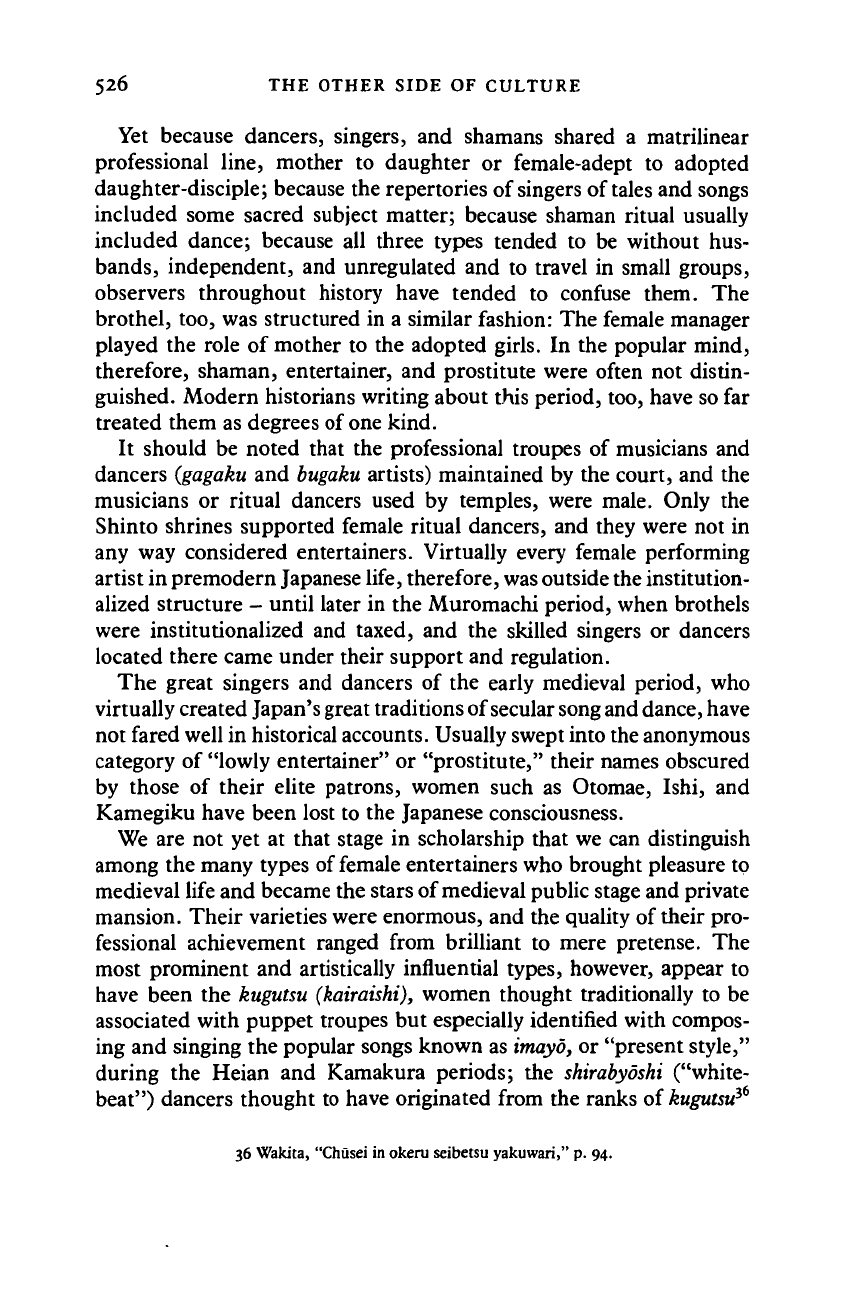
526 THE OTHER SIDE OF CULTURE
Yet because dancers, singers, and shamans shared a matrilinear
professional line, mother to daughter or female-adept to adopted
daughter-disciple; because the repertories of
singers
of
tales
and songs
included some sacred subject matter; because shaman ritual usually
included dance; because all three types tended to be without hus-
bands,
independent, and unregulated and to travel in small groups,
observers throughout history have tended to confuse them. The
brothel, too, was structured in a similar fashion: The female manager
played the role of mother to the adopted girls. In the popular mind,
therefore, shaman, entertainer, and prostitute were often not distin-
guished. Modern historians writing about this period, too, have so far
treated them as degrees of one kind.
It should be noted that the professional troupes of musicians and
dancers
(gagaku
and
bugaku
artists) maintained by the court, and the
musicians or ritual dancers used by temples, were male. Only the
Shinto shrines supported female ritual dancers, and they were not in
any way considered entertainers. Virtually every female performing
artist in premodern Japanese life, therefore,
was
outside the institution-
alized structure - until later in the Muromachi period, when brothels
were institutionalized and taxed, and the skilled singers or dancers
located there came under their support and regulation.
The great singers and dancers of the early medieval period, who
virtually created Japan's great traditions of secular song and
dance,
have
not fared well in historical accounts. Usually swept into the anonymous
category of "lowly entertainer" or "prostitute," their names obscured
by those of their elite patrons, women such as Otomae, Ishi, and
Kamegiku have been lost to the Japanese consciousness.
We are not yet at that stage in scholarship that we can distinguish
among the many types of female entertainers who brought pleasure tp
medieval life and became the stars of medieval public stage and private
mansion. Their varieties were enormous, and the quality of their pro-
fessional achievement ranged from brilliant to mere pretense. The
most prominent and artistically influential types, however, appear to
have been the
kugutsu
(kairaishi),
women thought traditionally to be
associated with puppet troupes but especially identified with compos-
ing and singing the popular songs known as
imayo,
or "present style,"
during the Heian and Kamakura periods; the
shirabyoshi
("white-
beat") dancers thought to have originated from the ranks of
kugutsu
36
36 Wakita, "Chusei in okeru seibetsu yakuwari," p. 94.
Cambridge Histories Online © Cambridge University Press, 2008
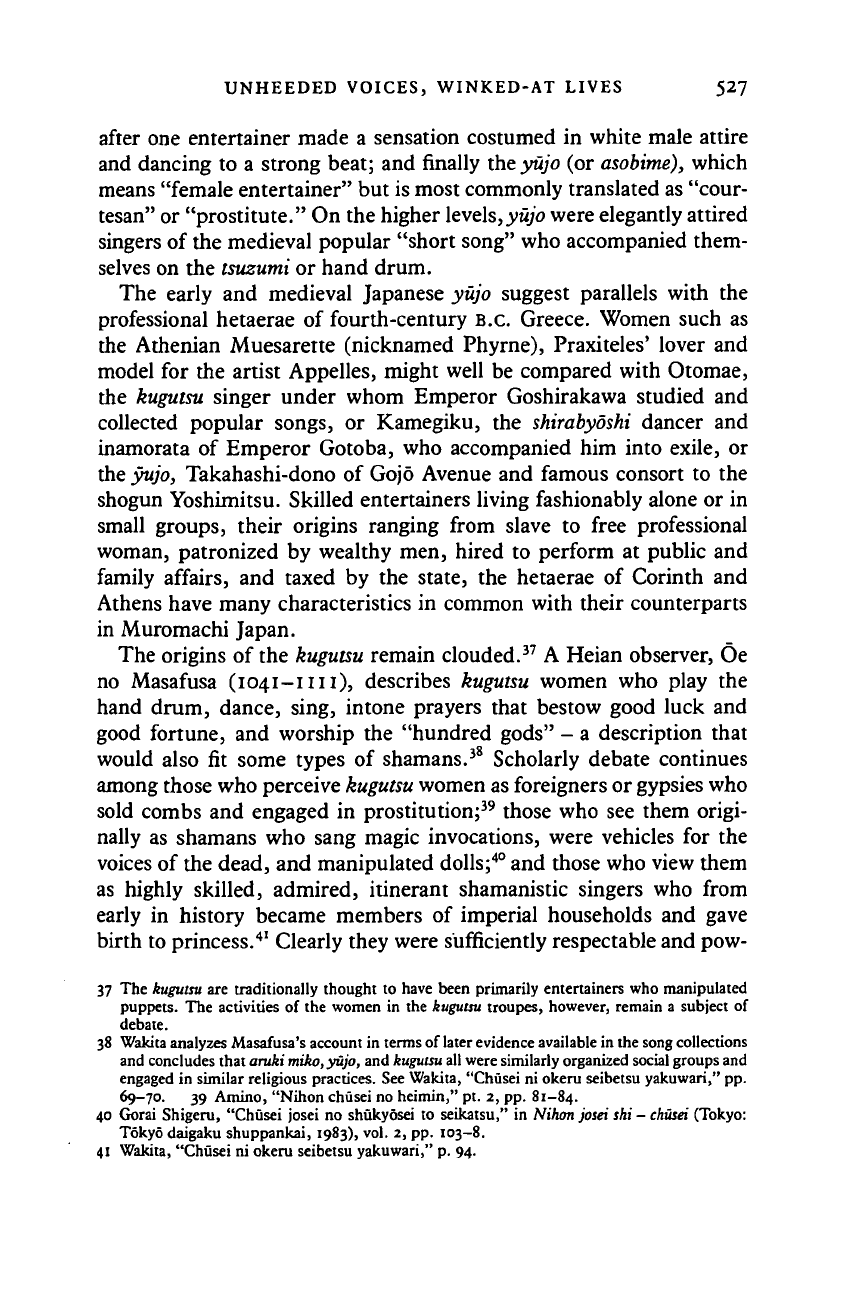
UNHEEDED VOICES, WINKED-AT LIVES 527
after one entertainer made a sensation costumed in white male attire
and dancing to a strong beat; and finally the yujo (or asobime), which
means "female entertainer" but is most commonly translated as "cour-
tesan" or "prostitute." On the higher levels,yujo were elegantly attired
singers of the medieval popular "short song" who accompanied them-
selves on the tsuzumi or hand drum.
The early and medieval Japanese yujo suggest parallels with the
professional hetaerae of fourth-century B.C. Greece. Women such as
the Athenian Muesarette (nicknamed Phyrne), Praxiteles' lover and
model for the artist Appelles, might well be compared with Otomae,
the kugutsu singer under whom Emperor Goshirakawa studied and
collected popular songs, or Kamegiku, the shirabyoshi dancer and
inamorata of Emperor Gotoba, who accompanied him into exile, or
the yujo, Takahashi-dono of Gojo Avenue and famous consort to the
shogun Yoshimitsu. Skilled entertainers living fashionably alone or in
small groups, their origins ranging from slave to free professional
woman, patronized by wealthy men, hired to perform at public and
family affairs, and taxed by the state, the hetaerae of Corinth and
Athens have many characteristics in common with their counterparts
in Muromachi Japan.
The origins of the kugutsu remain clouded.
37
A Heian observer, Oe
no Masafusa (1041-1111), describes kugutsu women who play the
hand drum, dance, sing, intone prayers that bestow good luck and
good fortune, and worship the "hundred gods" - a description that
would also fit some types of shamans.
38
Scholarly debate continues
among those who perceive kugutsu women as foreigners or gypsies who
sold combs and engaged in prostitution;
39
those who see them origi-
nally as shamans who sang magic invocations, were vehicles for the
voices of the dead, and manipulated dolls;
40
and those who view them
as highly skilled, admired, itinerant shamanistic singers who from
early in history became members of imperial households and gave
birth to princess.
41
Clearly they were sufficiently respectable and pow-
37 The
kugutsu
are traditionally thought to have been primarily entertainers who manipulated
puppets. The activities of the women in the
kugutsu
troupes, however, remain a subject of
debate.
38 Wakita analyzes Masafusa's account in terms of
later
evidence available in the song collections
and concludes that aruki miko,yujo, and
kugutsu
all were similarly organized social groups and
engaged in similar religious practices. See Wakita, "Chusei ni okeru seibetsu yakuwari," pp.
69-70.
39 Amino, "Nihon chusei no heimin," pt. 2, pp. 81-84.
40 Gorai Shigeru, "Chusei josei no shukyosei to seikatsu," in Nihon josei shi -
chusei
(Tokyo:
Tokyo daigaku shuppankai, 1983), vol. 2, pp. 103-8.
41 Wakita, "Chusei ni okeru seibetsu yakuwari," p. 94.
Cambridge Histories Online © Cambridge University Press, 2008
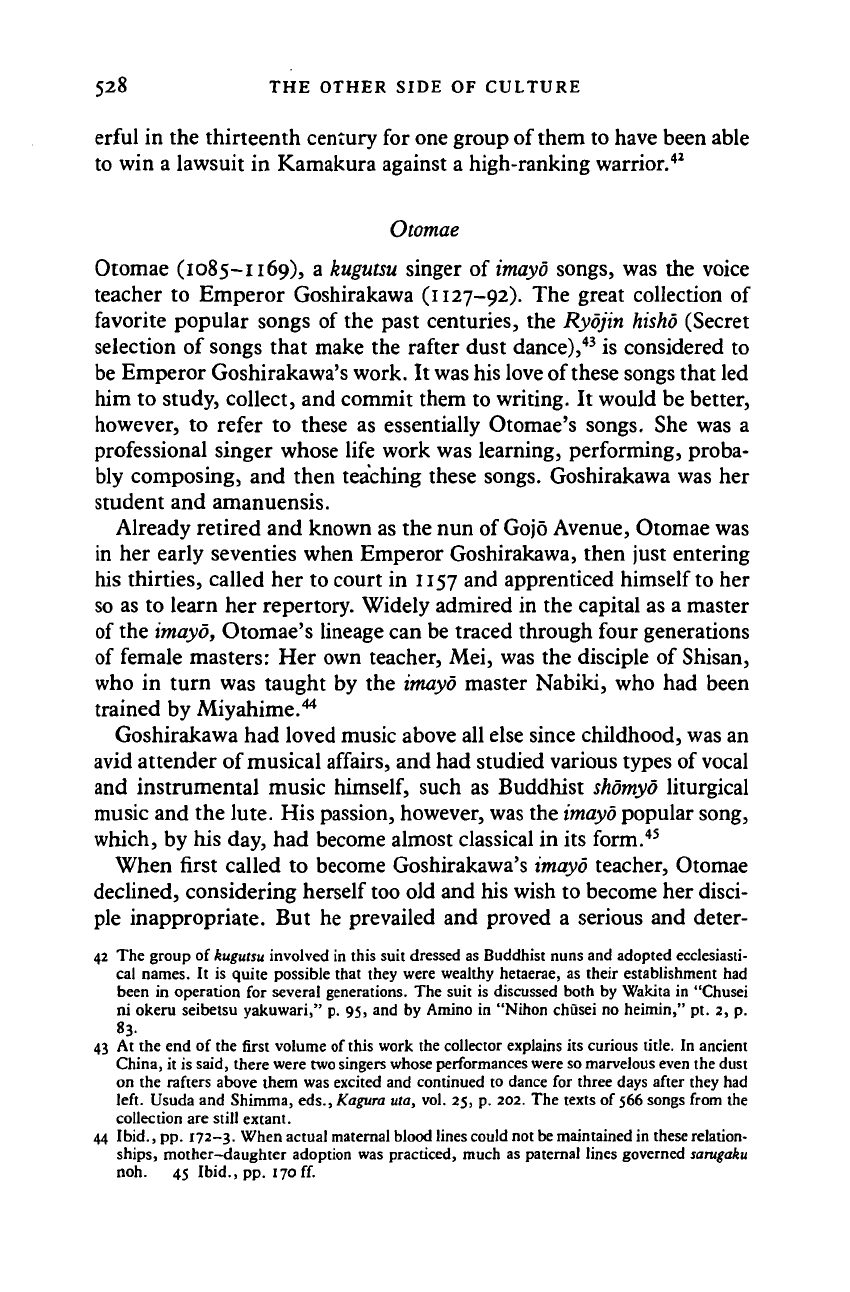
528 THE OTHER SIDE OF CULTURE
erful in the thirteenth century for one group of them to have been able
to win a lawsuit in Kamakura against a high-ranking warrior.
42
Otomae
Otomae (1085-1169), a
kugutsu
singer of
imayo
songs, was the voice
teacher to Emperor Goshirakawa (1127-92). The great collection of
favorite popular songs of the past centuries, the Ryojin
hisho
(Secret
selection of songs that make the rafter dust dance),
43
is considered to
be Emperor Goshirakawa's work. It was his love of these songs that led
him to study, collect, and commit them to writing. It would be better,
however, to refer to these as essentially Otomae's songs. She was a
professional singer whose life work was learning, performing, proba-
bly composing, and then teaching these songs. Goshirakawa was her
student and amanuensis.
Already retired and known as the nun of
Gojo
Avenue, Otomae was
in her early seventies when Emperor Goshirakawa, then just entering
his thirties, called her to court in 1157 and apprenticed himself to her
so as to learn her repertory. Widely admired in the capital as a master
of the
imayo,
Otomae's lineage can be traced through four generations
of female masters: Her own teacher, Mei, was the disciple of Shisan,
who in turn was taught by the
imayo
master Nabiki, who had been
trained by Miyahime.
44
Goshirakawa had loved music above all else since childhood, was an
avid attender of musical affairs, and had studied various types of vocal
and instrumental music
himself,
such as Buddhist
shomyo
liturgical
music and the lute. His passion, however, was the
imayo
popular song,
which, by his day, had become almost classical in its form.
45
When first called to become Goshirakawa's
imayo
teacher, Otomae
declined, considering herself too old and his wish to become her disci-
ple inappropriate. But he prevailed and proved a serious and deter-
42 The group of
kugutsu
involved in this suit dressed as Buddhist nuns and adopted ecclesiasti-
cal names. It is quite possible that they were wealthy hetaerae, as their establishment had
been in operation for several generations. The suit is discussed both by VCakita in "Chusei
ni okeru seibetsu yakuwari," p. 95, and by Amino in "Nihon chusei no heimin," pt. 2, p.
83.
43 At the end of the first volume of this work the collector explains its curious title. In ancient
China, it is said, there were two singers whose performances were so marvelous even the dust
on the rafters above them was excited and continued to dance for three days after they had
left. Usuda and Shimma, eds., Kagura uta, vol. 25, p. 202. The texts of 566 songs from the
collection are still extant.
44 Ibid., pp. 172-3. When actual maternal blood lines could not be maintained in these relation-
ships,
mother-daughter adoption was practiced, much as paternal lines governed
sarugaku
noh.
45 Ibid., pp. 170 ff.
Cambridge Histories Online © Cambridge University Press, 2008
